A History of the County of Hertford: Volume 2. Originally published by Victoria County History, London, 1908.
This free content was digitised by double rekeying. All rights reserved.
'Watford: Manors', in A History of the County of Hertford: Volume 2, (London, 1908) pp. 451-464. British History Online https://www.british-history.ac.uk/vch/herts/vol2/pp451-464 [accessed 11 April 2024]
MANORS
The manor of WATFORD, according to a monastic writer of the fifteenth century, was granted by Offa, king of Mercia, to St. Albans Abbey, (fn. 1) and though no mention is made of it in any of Offa's charters, it may have been covered by the grant of Cassio (q.v.). There is, however, still extant the will of Ethelgiva or Ethelgifu (942–6), in which she leaves the 'land of Watford' to Leofrune. (fn. 2) This land appears afterwards to have passed to Edwin of Caddington, who left it to the abbey of St. Albans by a will earlier than 1066. (fn. 3) Watford is not mentioned in the Domesday Survey, but was probably again included in Cassio (q.v.). (fn. 4)
In the civil wars in the reign of John a sum of £100 and a palfrey worth 10 marks were exacted from the abbot for this manor, and a little later a further sum of 100 marks was demanded. (fn. 5)
Land in Watford, and various rents and services there, were acquired by Abbot Roger (1260–90) of William Blaket, (fn. 6) and at about the same time various tenements and rents in the parish were bought from William Atehale, Reginald de Ponte, William Chalfhunte and Edith his wife, John Dekene, Ralph Clubbe and others, and Roger le Marchaunt gave meadow land lying in the meadow 'de la Holme.' (fn. 7)
The men of Watford were amongst those who joined with the men of St. Albans in rising against the abbot at the time of Wat Tyler's rebellion. (fn. 8) They, with the men of Cassio, obtained a charter in 1381 which granted them the right of hunting all wild animals and fishing in all the waters of the vill, and snaring birds both in the demesne lands of the abbey and in all other lands in the vill. They obtained freedom from suit at the court of the abbot, and relief from an imposition called 'Alepeny,' said to have been unjustly levied for a long time past, and from all other tolls and works on bridges and parks. They also extorted from the abbot licence to use handmills in their houses, with the accompanying freedom from suit at the abbey mill. (fn. 9) All these liberties were taken away within the year, and the townsmen reduced to their former state of subjection. (fn. 10)
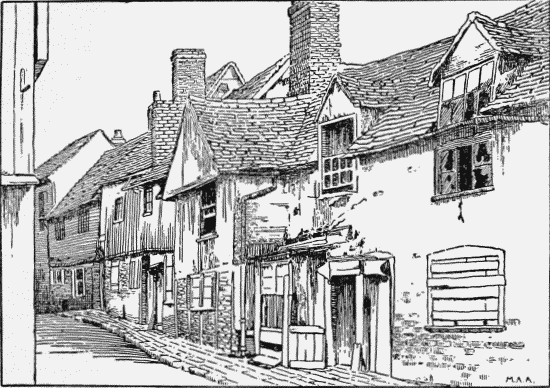
Watford: Houses in Church Street, Demolished in 1893
This manor remained part of the possession of the monastery till the Dissolution, (fn. 11) at which time Sir John Russell was farmer of the manor. (fn. 12) It continued in the crown till 1609, when it was granted to Thomas Marbury and Richard Cartwright, (fn. 13) who immediately conveyed it to Thomas Egerton, Lord Ellesmere, (fn. 14) the Lord Chancellor, who was created Viscount Brackley in 1616. (fn. 15) He died a few months after, seised of the manor, which passed to his son and heir, John earl of Bridgewater. (fn. 16) It descended with the title (fn. 17) till Francis, third duke of Bridgewater, sold it in 1767 (fn. 18) to Sir Lawrence Dundas, of Moor Park, (fn. 19) who apparently mortgaged it, for it was bought of the mortgagees in 1770 by William Ann Holles Capell, fourth earl of Essex. (fn. 20) This nobleman was one of the lords of the Bedchamber to George II, and succeeded William Earl Cowper, in 1764, in the Lord Lieutenancy of Hertfordshire. From him the manor of Watford has descended with the title to George, the present earl of Essex.
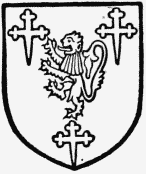
Capell, Earl of Essex. Gules a lion or between three crosslets fitchy or.
Watford in 1605 included the tithings of 'Caser,' Leavesden, Oxhey, and Sarratt. (fn. 21) There is mention in the thirteenth century of Great Oxhey, Little Oxhey, Est Oxhey, and Oxhey Abbatis. (fn. 22) The metes and bounds of the manor and parish of Watford were ascertained in 1605. Beginning at Townesend Bridge, or the Great Bridge of Watford, and thence by the lane called Carpenters' Lane to Maroke, by estimation two miles; thence by le Shirediche to Potters Street, by estimation one mile; and thence to Tredwager House or le Old Lodge, by estimation one mile, and thence to Rickmansworth More Bridge, called Highe Bridge, by estimation one mile; and thence by the meadow of the earl of Bedford westerly to Blakemore Water, and by the same river to Casho Bridge, by estimation a mile; and thence by High Grove Lane to Redheath, to an oak there, by estimation a mile; and thence by Cloblane to Peacche Hill, by estimation half a mile; and thence to Maplecrosse to Common Woodd Corner; and thence to lez Cheritrees in Mans Greene, by estimation a mile; and thence to Chipperfield Wood Corner, and thence to a lane called Shepperdes Lane, by estimation a mile; and thence to the southward part of Langley Bery groundes to the river, and thence to Touley's House, by estimation a mile; and thence to the house of William Hill, of Leavesden, by estimation a mile; and thence by the way leading from Langley Abbatis towards Watford, to the north part of Mayns Close, by estimation three parts of a mile; and thence by the north part of Leavesden Wood to Water Del Street, to the pond there, by estimation a mile; and thence by the north and east parts of le Great Springe to Garston Gate, by estimation a mile; and thence by the north and east parts of Moredens Groundes to Colney Stream, by estimation half a mile; and thence by the river aforesaid to Leggatshot (?) Meade; and thence by the east part of the meadow aforesaid to Garston Weare; and thence near Bushye Mill to Townesend Bridge, or the Great Bridge of Watford aforesaid, by estimation two miles. (fn. 23)
Owing to its situation between the two rivers, the Gade and the Colne, there have from early times been several mills here. There were four mills at Cassio at the time of the Domesday Survey, (fn. 24) one of which, it afterwards appears, was at Watford, another at the Grove, a third at Cassio, and the fourth at Oxhey. The mill of Watford belonged to the abbey of St. Albans, and was the one at which all the men of Watford were obliged to grind their corn. (fn. 25) This mill was close to the mill of Bushey, and in the reign of Edward I trouble arose between the abbot and David de Jarpenville, lord of Bushey, because the latter had damaged the abbey mill, but David afterwards recognized his error. (fn. 26) The abbot also had a fishery at Watford, and in the lawless times under Edward II the townspeople of Watford trespassed in the abbot's several fishery. (fn. 27) John Wellys of Watford seems to have laid claim to the mill-pond of Watford in 1431, but the result of the suit which thereupon arose between him and the abbot is not given. (fn. 28) Under Abbot John of Wheathampstead a sum of £41 3s. 6d. was spent on repairs to this mill. (fn. 29) In the time of the same abbot certain of the inhabitants of Watford began to erect a horse-mill at Watford, but they were successfully opposed by the abbot. (fn. 30) The mill and fishery at the Dissolution came to the crown. The fishery and all the shops newly erected upon the waste at Watford were granted in 1579–80 to John Farnham, (fn. 31) and the mill in 1609 to Edward Ferrers and Francis Phillips, (fn. 32) the fee-farm rent of £13 from the mill paid by them being granted at the same date to Sir Christopher Hatton and others. (fn. 33) Ferrers and Phillips sold the mill in the same year to Sir Thomas, Lord Ellesmere, (fn. 34) who died seised of it in 1616–17, (fn. 35) and it subsequently passed, with the manor, to the earls of Essex. (fn. 36) The present Watford Mill is the representative of this old abbatial mill.
The water-mill at Cassio was called Tolpade, and was in 1364 held by John son of William Aignel. It was then in a ruinous condition, (fn. 37) and probably was never repaired, as nothing more is heard of it, and there is no mill at Cassio at the present day. This mill is perhaps the same as the fulling-mill at Cassio which was given in 1255–6 by John abbot of St. Albans to Petronilla de Ameneville for life. (fn. 38)
Grove Mills seem always to have been appurtenant to the manor of Grove (q.v.), and are described in 1631–2 as two water-mills called the Grove Mills, standing under one roof. (fn. 39) The present representative of these mills is on the Gade, on the border of Grove Park.
The mill of Oxhey was held in early times by the tenants of the manor of Oxhey (q.v.). (fn. 40) After the division of the manor a second mill must have been built, for there appears to have been one attached to each part. (fn. 41) Oxhey Mill came after the Dissolution to George Zowche, from whom it took the name of 'Souches mill.' (fn. 42) He conveyed it in 1542–3 to the king, (fn. 43) and it was apparently afterwards granted to Thomas Heritage, who was holding it in 1556. (fn. 44) It was then called Hamper Mill, and that name has survived to the present day. Heritage evidently held the mill under a lease from the crown, for the mill was granted by Philip and Mary to their servant Francis Pitcher for forty years, and in 1578 he surrendered this lease to John Pople. (fn. 45) In 1597 Sir William Brooke, Lord Cobham, died seised of Hamper Mills, which were then two water corn mills. (fn. 46) Sir William was succeeded by his son Henry, and Hamper Mills passed from him to Sir James Altham, (fn. 47) from whose family it passed, in the same manner as Oxhey, to John Heydon. At the time of the sale to Heydon in 1639 three mills were included under the name Hamper Mills. Later on the mills came into the possession of the Clothworkers' Company, and in 1881 were the property of Mr. J. G. Smith. (fn. 48) These mills are on the Colne, to the south-west of Oxhey Hall, and now belong to Mr. J. G. Smith.
In the middle of the last century there was a silk mill belonging to Thomas Rock Shute, called Rookery Silk Mill, situated a short distance north-east of Hamper Mill. It was closed before 1881, (fn. 49) and on its site the Watford Steam Laundry and Dye Works now stand.
The manor of CASSIO or CASSIOBURY (Caegesho x cent.; Caissou, Chaissou xi cent.; Caishoo xiv cent.). By a doubtful charter of Offa, thirty-four 'mansiones' at Cassio were granted to the abbey of St. Albans. (fn. 50) At the time of the Domesday Survey Cassio was assessed at twenty hides, and contained woodland to feed a thousand swine. (fn. 51) This holding, which probably included the whole manor of Watford, belonged to the abbey of St. Albans, and had belonged to it in the time of King Edward. (fn. 52) One hide in Cassio, which Turold held of Geoffrey de Mandeville, had formerly been held by Alwin the huntsman, one of Queen Edith's men, but Geoffrey attached this hide to Bushey, one of his principal manors in this part of Hertfordshire, to which it did not belong in the time of King Edward. (fn. 53) Abbot John in 1255–6 leased the capital messuage of Cassio and a fulling mill to Petronilla de Ameneville in exchange for land in Micklefield and elsewhere, (fn. 54) reserving to himself all perquisites of court, tallages, and escheats. The grant was confirmed by Henry III in order that Petronilla might not be ejected during a vacancy of the abbey, (fn. 55) and was to endure as long as she should wear the religious habit, which, however, she discarded on her marriage with John de Grava, when this lease became void. In 1271 she and her husband released to the abbot all their claim in the manor, saving to themselves the right to fish and hunt in the demesne and the use of a house at St. Albans near the tannery of the monastery. (fn. 56)
This manor provided twenty-four hens at Christmas, six hundred eggs at Easter, and twenty-four cheeses at the Passion of St. Alban, to the abbey kitchen. (fn. 57) Abbot John de la Moote built a new barn, (fn. 58) and under Abbot John of Wheathampstead a new cowhouse was built there. (fn. 59) In 1428 the manor was farmed by Thomas Lavenham, (fn. 60) and at the Dissolution it was held by William Dauncey under a lease of 1532 for thirty-one years. (fn. 61)
The manor of Cassiobury, with the woods called Cashio Grove and Whependen Grove, was granted in 1545 to Sir Richard Morrison, (fn. 62) who began a mansion at Cassiobury, which was completed by his son Charles, who succeeded his father in 1556. The manor was held for life by Bridget relict of Sir Richard, (fn. 63) who had married Francis earl of Bedford as her third husband. (fn. 64) Bridget outlived her son, who died in 1599 seised of the reversion, leaving Charles his son and heir, a minor, whose wardship was committed to Bridget his grandmother, Henry earl of Kent, and Thomas lord Grey of Wilton. (fn. 65) Bridget died in 1600, (fn. 66) and the property passed to her grandson Sir Charles, who died in 1628, leaving an only daughter Elizabeth, (fn. 67) who married Arthur Capell, created Lord Capell of Hadham in 1641. As a loyal adherent of Charles I he forfeited all his estates under the Commonwealth, Cassiobury and the rectory of Watford being granted in 1645 to Robert Devereux earl of Essex, leader of the Parliamentary forces. (fn. 68) Lord Capell was beheaded in 1648–9, but at the Restoration his lands were given back to his son Arthur, created Viscount Malden and earl of Essex in 1661. (fn. 69) He had in the previous year been made custos rotulorum and lord lieutenant of Hertfordshire, and in 1668 was made lord lieutenant of Wiltshire also. He became lord lieutenant of Ireland in 1672, and the purity of his administration there, which lasted five years, was in striking contrast to the general corruption prevailing at the time. He was imprisoned in the Tower for complicity in the Rye House Plot, and died there before his trial, whether by murder or suicide has never been satisfactorily determined. (fn. 70)
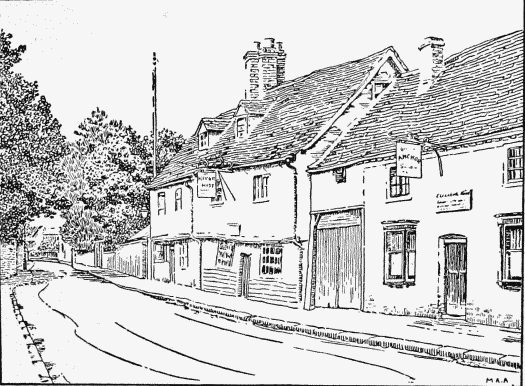
WATFORD HIGH STREET: 'THE HIT OR MISS'

Morrison. Or a chief gules with three wreaths or therein.
The manor descended from him with the title to George, the present earl.
Sir Charles Morrison added several estates to the manor. Jacketts Farm was bought by him in 1620 of Thomas Baldwin; Leavesden Woods in 1625 and Tooleys Farm in 1628. Arthur earl of Essex added land called Breaches to the park in 1681, and Hatters Farm was parcel of the manor of Cassiobury in 1691. (fn. 71) Arthur earl of Essex in 1661 obtained licence to preserve game within ten miles of Cassiobury. (fn. 72)
The first mention of the park is in 1632, (fn. 73) but it was probably made by Richard Morrison, (fn. 74) and in 1819 it was between three and four miles in circumference, and embraced an area of 693 acres, of which 310 acres were called the Home Park, 256 acres the Upper Park, separated from the Home Park by the River Gade, and the remaining 127 acres were occupied by the house and gardens. (fn. 75) Defoe in his Tour says that on the north and east sides of the house are large wood-walks which were planted by the famous Le Notre in the reign of Charles II.
The old north wing of the house which was built in the H form was probably of an earlier date than the grant to Sir Richard Morrison, and its bay windows and plastered walls and the form of its chimney shafts showed a monastic character, possibly indicating its connexion with the abbey of St. Albans. Since the time of Charles Morrison, who completed the house, many additions and improvements were made. The first earl of Essex rebuilt the house, with the exception of the west wing, and in laying out the gardens he employed Moses Cook, (fn. 76) the author of a work on forest and fruit trees, published in 1679. John Evelyn in his Diary gives some account of Cassiobury, which he visited at the invitation of the earl of Essex. He says, 'the house is new, a plain fabric built by my friend Mr. Hugh May. There are divers fair and good rooms, and excellent carving by Gibbons. The library is large and very nobly furnished, and all the books are richly bound and gilded, but there are no manuscripts except Parliament rolls and journals, the transcribing and binding of which cost him (the earl of Essex), as he assured me, £500. No man has been more industrious in planting about his seat . . . . but the soil is strong, churlish, and uneven, nor is the water near enough to the house. . . . It is a pity the house was not situated to more advantage; but it seems that it was built just where the old one was, which, I believe, he only meant to repair. . . . The land about is exceedingly addicted to wood, but the coldness of the place hinders the growth. Black cherry trees prosper even to considerable timber, some being eighty feet long; they make also very handsome avenues.' (fn. 77)
About the year 1800 May's house was pulled down and the present one erected by James Wyatt, in the pseudo-gothic style. Some portions of one or other of the previous mansions are said to be incorporated with the existing one, and a few years ago some remains of brick cellars were discovered in front of the house.
In the thirteenth century mention is made of the soke and halimote of Caysho. (fn. 78)
Manor of OXHEY (Oxonage, Oxangehaege, xi cent.; Oxey Abbatis, Oxei, Oxeye, Oxsehaye, xiii cent.; Oxeya, Oxeye Abbatis, xiv cent.). —Land called Oxonage or Oxan gehaeg(e) was given to the abbey of St. Albans by Abbot Alfric, (fn. 79) and was confirmed to the abbey in 1007 by King Ethelred. (fn. 80) In this charter it is stated that the land once belonged to Offa king of Mercia, who gave it to the monastery, but that on his death it was taken away, and came into the hands of Leofsig. Leofsig was banished in 1002 for the murder of the king's reeve Aefic, (fn. 81) and the land returned into the possession of the crown. Ethelred gave it to Alfric and Leofric his brother, and they granted it to the monastery. (fn. 82) There is no mention of the manor in Domesday, but it was probably included with the rest of Watford under Cassio. (fn. 83) During the twelfth and thirteenth centuries the holders of this manor took their name from it. Walchelin de Oxhey was holding land in Hertfordshire in 1164–5, (fn. 84) and is perhaps identical with the Walkelin de Oxen 'miles strenuissimus' who unhorsed and wounded the earl of Arundel in the water of Haliwell in 1142, when the knights of St. Albans resisted the entry of Stephen into the town of St. Albans. (fn. 85) In 1182–3 this manor, with that of Croxley in Rickmansworth, formed one knight's fee, which was held by Richard de Croxley and Philip de Oxhey, (fn. 86) and tenants of the same name were holding this fee in 1210. (fn. 87) Shortly after this time the manor or part of it seems to have been mortgaged by Colmer de Oxhey to Elias Episcopus, a Jew of London, (fn. 88) and in 1244 an entry is made in the Jewish Exchequer that Elias had received 50s. of the farm of Oxhey, which Elias paid to the prior of Hurley. (fn. 89) This rent had apparently been assigned to the prior by Nicholas de Oxhey, and about 1245 the abbot of St. Albans disputed the right of Nicholas as mesne tenant to mortgage the manor, (fn. 90) and eventually redeemed it from Elias. (fn. 91)
The descent of the manor after this date is obscure, but from the annals of St. Albans it would seem that the whole fee, including the manors of Croxley and Oxhey, came into the hands of one man, bearing the name de Croxley, (fn. 92) who had two sons, Richard the elder who died without heirs, and Roger who left three daughters, Petronilla the wife of Robert de Ameneville, Beatrice wife of John de Shelford, and Joan wife of Thomas de Wauncy. (fn. 93) Petronilla had two daughters both called Petronilla. The elder married Nicholas de Oxhey, (fn. 94) and the younger married Hugh de Vynon, by whom she apparently had two daughters, who married John de Westwick and Nicholas de Whethamsted. Thomas and Joan de Wauncy had a son Thomas, who died young, and three daughters, Joan who married Ralph de Lynleye or Glynley, Agnes the wife of Roger Cissor or le Tailour, and Alice the wife of Richard de Tingwicke. (fn. 95) Beatrice de Shelford left no issue, and her share in the manors of Croxley and Oxhey came to her sisters. (fn. 96) In consequence perhaps of the division of the manors into so many parts, we find the various co-heirs granting their shares to the abbot of St. Albans, overlord of the whole fee. (fn. 97) Richard de Oxhey was the heir of Nicholas and Petronilla de Oxhey, and in 1276 he released all his claim to land in Oxhey to the abbot, in exchange for which the abbot gave him all the demesne and half a mill, given to the abbey by Petronilla de Ameneville, reserving to the abbey perquisites of court and other dues. At the same time an agreement was made whereby masses and prayers were to be said by the convent for Richard and his two wives H[uge]line and Joan. (fn. 98) On the anniversary of their deaths two poor people were to be fed and given 6d. (fn. 99) The grant to Richard appears to have been only during the lives of Richard and Joan his wife, for in 1282 Richard regranted to the abbey certain of the lands in Little Oxhey which he held by grant of the abbot for life, namely a grove and pasture which lay between the stream coming from Watford and the highway as far as the mill of Oxhey, which grove once belonged to the house of Waleran Tyeis. (fn. 100) This grant is perhaps the origin of the two manors which afterwards existed at Oxhey, one called Oxhey Richard and the other called Oxhey Walround. The part retained by Richard, called OXHEY RICHARD, was held for the service of a quarter of a knight's fee, and for suit at the court of the abbot at St. Albans every three weeks, (fn. 101) and is found later in the possession of Richard's descendants. The second manor perhaps took its name from Waleran Tyeis, and is later found in the possession of the other coheirs.
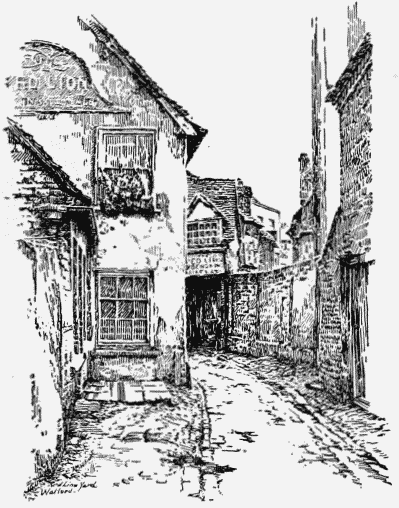
Red Lion Yard, Watford
Richard was presented in 1278 for preventing the men of Oxhey from fishing in the waters of Great Oxhey. He claimed the fishery through his mother, but the right of the men of the vill was established. (fn. 102) He died about 1295, and the manor came to his wife Joan, who was an alien, a subject of the king of France, and as such her lands were seized by the king. She resisted the bailiff of the liberty of St. Albans, sent to eject her, and was imprisoned for the offence. (fn. 103) An extent of the manor was taken at this time and there was there a dovecot and a water-mill with a fishery. A detailed account is also given of the contents of the house and the stocking of the farm. (fn. 104) In the same year, however, Joan came to an agreement with the king by which she was allowed to retain possession of the manor of Oxhey Richard. (fn. 105) It would appear that she afterwards married Ralph de Hurle, for in 1298 he and his wife conveyed the manor to William Tolymer and John son of Geoffrey de Whethamstede and Margaret his wife, who were the heirs of Richard de Oxhey, in exchange for a rent of 5 marks, to be paid out of the manor to Ralph and Joan, (fn. 106) and in 1303 these feoffees were holding a quarter of a knight's fee in Oxhey Richard of the abbot of St. Albans. (fn. 107) William Tolymer conveyed his moiety of the manor in 1316 to Eubold de Montibus and Elizabeth his wife, (fn. 108) who were still holding it in 1332–3. (fn. 109) This half, which consisted of an eighth part of a knight's fee, had in 1347–8 passed to Edward de Montibus son of Eubold, (fn. 110) and was held by his heirs in 1428. (fn. 111)
The half of the manor held by John de Whethamstede had passed in 1320–1 to his son Thomas, (fn. 112) and in 1347–8 it was held by William de . . ., (fn. 113) in right of Christiana his wife. (fn. 114) It appears afterwards to have passed to Roger de Louthe, for he in 1360 obtained a grant of free warren over his demesne lands of Oxhey. (fn. 115) It is probable that his widow Amice married Richard de Bromwych, for in 1370 they settled the manor of Oxhey Richard upon themselves and their issue, with remainder to Amice's children, John, Joan, Katherine, and Margaret, and to Thomas son of Thomas de Louthe in tail male with contingent remainder to the right heirs of Amice. (fn. 116) Amice de Louthe was holding the manor in 1374 of the heritage of John de Louthe her son. (fn. 117) Her daughters Joan and Katherine appear to have married William Petevyn and Thomas Wybsnade, and in 1397 conveyed their interest in the manor to Edward earl of Rutland and others, (fn. 118) who were probably trustees for Robert de Louthe, who seems to have been the heir of John de Louthe. In 1414–15 Robert, younger son of Robert de Louthe of Rokesford, granted all his right in the manor of Oxhey Richard to Sir Hugh de Holes, justice of the King's Bench, (fn. 119) who died seised of it in 1416, leaving Thomas his son and heir. (fn. 120) Thomas died in 1420–1, and the manor came to his son Thomas, a child of two years of age. (fn. 121) He apparently died in infancy, for in 1432 Margaret daughter and heir of Thomas de Holes, then wife of John Troutbek, made proof of her age, (fn. 122) and the manor was settled upon her and her husband in 1444–5. (fn. 123) After the death of John Troutbek it descended to his son William, (fn. 124) who died seised of it in 1460, leaving William his son and heir. (fn. 125) William Troutbek in 1482 conveyed the manor to John Wode, Peter Curteys, and William Daubeney and the heirs of Peter. (fn. 126) A few years later the site of the manor of Oxhey called Oxhey Hall was in the possession of Randolph Billington, who sold it to John Brown. (fn. 127)
The history of the moiety held by Edward de Montibus is lost from 1428, and probably passed with the manorial rights of Oxhey Richard into the hands of the overlord, the abbot of St. Albans, and was included in the manor of Wiggenhall cum Oxhey, which formed part of the possession of the abbey of St. Albans at the time of the Dissolution. (fn. 128)
The estate called Oxhey Hall was held for the service of suit at court at the manor of Croxley, (fn. 129) and half of it was conveyed in 1566 by John Newdigate (to whom it had descended from his father George) to Francis Heydon, (fn. 130) and the other half was sold to the same Francis in 1571 by Francis Newdigate and John Newdigate and Martha his wife. (fn. 131) From Francis Heydon this manor was purchased by John Franklyn and his son Richard. (fn. 132) John died seised of it in 1596, leaving Richard his son and heir, (fn. 133) on whose death in 1627 the estate passed to his son Sir John Franklin. (fn. 134) It seems to have been leased by the Franklins to John Anderson or Potter, and was occupied by him in 1604. (fn. 135) The further history of Oxhey Hall is not known, but it probably became merged in the manor of Wiggenhall (q.v.).
Oxhey Hall, now a farmhouse about a mile north-west of Oxhey chapel, has in one of the rooms a fine old oak panelled ceiling. The house has been much modernized, and contains nothing else of interest.
The estate now known as OXHEY was at one time part of Oxhey Hall. (fn. 136) Roger de Louthe had licence in 1360 to inclose and make a park of his woods of Gipps and Edeswyk. (fn. 137) This park was disparked in 1598, when licence was granted to Francis Heydon to cut down the timber in the park of Oxhey and convert it into tillage, (fn. 138) and in 1601 Francis sold to Henry Fleetwood of Gray's Inn all the capital messuage called St. Cleeres or St. Clowes in Oxhey, and the impaled or warren ground with the Warren house or lodge called Edeswick or Oxhey Lodge, and also part of the old park called Oxhey Park, and the house called Merry Hill House or Hamonds lying near Oxhey Wood, in the tenure of William Hamond by lease of Francis Heydon. The extent of these lands amounted to about 500 acres. (fn. 139) In the following year Henry Fleetwood sold the estate to Robert Bowyer and Richard Fusse of London, (fn. 140) and two years later they conveyed it to James Altham, serjeantat-law. (fn. 141) He was appointed one of the barons of the Exchequer and knighted in 1606, and was one of the judges whose opinion was taken in 1612 by Lord Chancellor Ellesmere upon the case of 'two blasphemous heretics,' Legate and Wightman, whom Archbishop Abbot was desirous of burning. Probably Altham concurred with Williams his fellow judge, who, Abbot wrote, 'maketh no doubt but that the law is cleere to burn them,' for eventually both the heretics were burned, one at Smithfield and the other at Burton-on-Trent. Altham died in 1617, and Lord Keeper Sir Francis Bacon, in appointing his successor, characterized the late baron as 'one of the greatest and most reverend judges of the kingdom.' (fn. 142) He was buried in a chapel erected by him in 1612 at Oxhey, and left an only son James, who married Elizabeth daughter of Sir Richard Sutton. James died in 1623, leaving an infant son, Sutton, and two daughters. (fn. 143) Sutton died in 1630 and the estate passed to his sisters, Elizabeth wife of Arthur Annesley, son and heir of Lord Mountnorrice, and Frances, who married Richard earl of Carbery. (fn. 144) These coheirs sold the estate in 1639 to John Heydon of Lincoln's Inn, (fn. 145) of whom it was purchased in 1668 by William Bucknall of London. (fn. 146) William's son, Sir John Bucknall, pulled down the old mansion known as St. Cleere's in 1688, and erected in its place a large square building of brick, reputed to have a hundred windows on each side. (fn. 147) The estate descended in the family of Bucknall in the same way as Wiggenhall (q.v.), and the mansion built in 1688 was demolished in 1799 by Sir William Bucknall. (fn. 148) It was sold by Thomas Sotheron Estcourt in 1866 to the Right Hon. William Henry Smith. (fn. 149) By this owner part of the estate was sold in building lots, and the remainder was sold in 1877 to Thomas Blackwell of the firm of Crosse & Blackwell, (fn. 150) from whom it descended to his son the late Thomas F. Blackwell. The estate is now the property of his son Mr. Walter R. Blackwell, (fn. 151) who resides at Oxhey Place, an entirely new house.
The chapel, built by Sir James Altham in 1612 possibly on the site of an earlier one, still stands near Oxhey Place. The reredos is thought by Mr. Newton Price to have been erected about 1690, and to have been made from oak taken out of the old house pulled down in 1688. It was used for divine service till 1799, but from that date till 1852 it was used chiefly as a storage for lumber. Repairs were carried out at the latter date, and the chapel was again restored in 1897 at the expense of Mr. T. F. Blackwell, the stained deal introduced in 1852 being everywhere replaced by teak, the old Elizabethan windows restored, and the seats placed quirewise. (fn. 152)
In a survey of Oxhey taken in the reign of Charles I, Oxhey Place Hall is described as a very large house, which with orchard and garden was encompassed by a brick wall containing from 5 to 7 acres. There were many ponds on the demesne, and the house built by Baron Altham cost £3,000. (fn. 153) At that time the house called Merry Hill House, now in the parish of Bushey, was occupied by a certain Riccardo. (fn. 154)
The manor of OXHEY WALROUND seems to have included all that part of Oxhey which was not retained by Richard de Oxhey, and in 1303 was divided into three parts as follows among the various co-heirs:—The abbot held an eighth part of a knight's fee, Richard de Tingwicke, Ralph de Glynley, and Roger le Tailour, the heirs of Thomas de Wauncy, held a quarter of a knight's fee of the abbot, and Nicholas de Whethamsted and John de Westwick, heirs of Petronilla, the second daughter of Petronilla de Ameneville, held the remaining eighth part of a knight's fee. (fn. 155) Before 1320 the quarter of a knight's fee held by the heirs of Wauncy had been demised to the abbot, (fn. 156) who then held an eighth and a quarter of a knight's fee. Nicholas de Whethamstede and John de Westwick still held an eighth part of a fee at that date. (fn. 157) The abbot held the same proportion of the manor in 1347–8. Nicholas's share seems to have passed to John Mahew of Wheathampstead, and the share of John de Westwick had been divided between co-heirs or feoffees, William de la Marche and Thomas Blaket. (fn. 158) This William de la Marche is perhaps identical with the William de la Marche of Watford, the cook of Edward III, who came to the aid of the abbot when he was at strife with the men of the town of St. Albans, and did good service to the abbey. In reward for this he was granted an annuity of £10, a gown, and a cart-load of hay from the manor of Croxley, and undertook to be for ever faithful to the abbey. (fn. 159) William de la Marche and Agnes his wife conveyed a fourth part of the manor of Oxhey Walround in 1352 to John Lebard, of Strixton, chaplain, and William de Langeleye, (fn. 160) who were probably trustees for some settlement. The quarter of the manor not held by the abbot must soon after this time have become vested in Clementia wife of Richard de Eccleshale, for a plea arose between Abbot Thomas (1349–96) and Thomas Fitz John and William Windesore, husband of Alice Perrers, the famous mistress of Edward III, on account of this manor. (fn. 161) The abbot's story was that Clementia had conveyed all her estates in Oxhey and elsewhere to feoffees; part of them were to be used to support a perpetual chantry of four chaplains, and the rest, half the manor of Oxhey Walround being amongst them, were to be sold to raise money to pay for the alienation in mortmain of the other part. Oxhey Walround was sold by these feoffees to John Whitwell, steward of St. Albans, and Joan his mother, and after the death of John, Joan, in 1374, granted it to the abbot and convent, who would thus have become possessed of the whole manor. Thomas Fitz John claimed that he was heir of Clementia, and that the moiety of the manor of Oxhey Walround had been conveyed by Clementia to trustees to be alienated in mortmain to support a chantry. This condition had not been fulfilled, so Thomas entered upon the manor, and afterwards made a feoffment of the same to Alice Perrers. Between 1374 and 1377 the abbot and Alice seem to have been alternately in possession of the manor, but as she was 'of great power and eminence in those days,' the abbot was advised to postpone any open complaint in the king's court until a more favourable season. Alice was banished in 1377, and her lands were seized by the king, but were afterwards granted to her husband, Sir William Windesore. The lands at Oxhey were specially mentioned in the grant, but the abbot remained in peaceful possession until July, 1381. In that month forcible possession was taken of the premises in the name of Sir William, and much damage was done to the crops and to Oxhey Mill. John, son and successor of Sir William Windesore, in 1385 obtained a protection so that the suit pending with the abbot could not proceed, but in 1386 an agreement was made and judgement entered for the abbot. (fn. 162) In the course of this suit it appears that the capital messuage of the manor was called Whithynhalle, (fn. 163) and after this time the manor is known as Wiggenhall or Oxhey Walround. It also appears that the manor was leased by John Whitwell to Richard de Bromwich, probably the same Richard who was holding half the manor of Oxhey Richard in 1370. (fn. 164) On coming into possession of the manor the abbot assigned it to the sub-cellarer. (fn. 165) After this time successive abbots remained in peaceful possession of the manor till the Dissolution. (fn. 166) The site of the manor and of Oxhey Mill had been leased to Thomas Heydon for a term of years ending in 1546, and the reversion of this lease was granted for a further term of years to Hugh Byrde of Pinner, (fn. 167) the abbot reserving to himself the right to fish in the waters of Oxhey Mill. (fn. 168)
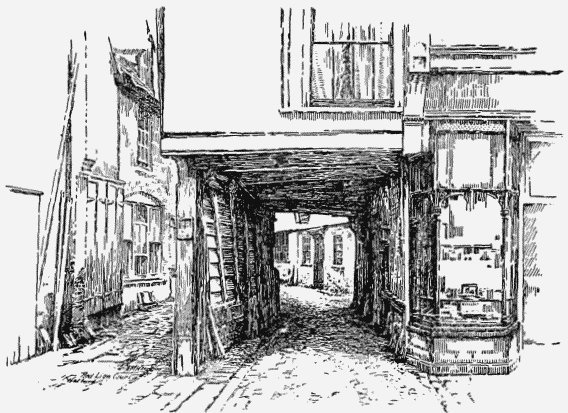
Red Lion Court, Watford
At the Dissolution the manor came to the crown, and was granted in 1540 to James Joskin, of London, and Joan his wife. (fn. 169) James died in 1549 leaving two sons, Robert and John, infants of a year old at the time of their father's death. They both died in 1552, and their sister Katherine, then aged twelve, was their heir. (fn. 170) Katherine married Thomas Brokesbye, by whom she had a son William, (fn. 171) but the manor of Wiggenhall was held for life by James's widow Joan, who married Gregory Lovell as her second husband. Joan died in 1570, and her grandson William Brokesbye was left to the care of Gregory, Thomas his father having become insane. (fn. 172) William, in return for the kindness of Gregory, settled this manor in 1580 on him and his second wife Dorothy for their lives, with remainder to his half-brother Bartholomew Brokesbye and others. (fn. 173) William died soon after, and Gregory and Dorothy held the manor till the death of Gregory, when Dorothy had some trouble in proving her claim against Bartholomew Brokesbye and Francis Heydon, (fn. 174) who held the part of the manor called Oxhey Hall (q.v.) as tenant of Dorothy. Bartholomew Brokesbye was found guilty of complicity in Watson's conspiracy to poison James I, and was attainted in 1603. (fn. 175) He was pardoned, however, in the following year, and his lands, among them his interest in the manor of Wiggenhall, were granted to Sir Thomas Tresham of Rushton (Northants), and Sir William Rooper of Eltham, in Kent, as trustees for Bartholomew. (fn. 176)
Dorothy Lovell married Sir Robert Cross as her second husband, (fn. 177) and they, with Bartholomew and Gregory Brokesbye, conveyed the manor in 1609 to Francis Ryder and William Leake. (fn. 178) This conveyance was evidently made for the purpose of a settlement, and further conveyances were made in 1624 by Gregory Brokesbye, probably son and heir of Bartholomew, (fn. 179) who held a court for the manor in 1647. (fn. 180) In 1664 a court was held by William Stych and Josua Brokesbye, widow, (fn. 181) probably relict of Gregory Brokesbye, Stych no doubt being a trustee. Thomas Stych, Josua Brokesbye, Edmund Chapman, Ralph Snowden, and Mary Wake conveyed the manor in 1675 to Sir William Bucknall, (fn. 182) knighted in 1670, (fn. 183) who was succeeded on his death in 1676 by his son Sir John, who died in 1711, when the manor passed to his son William. (fn. 184) On the death of William in 1746 the manor descended to John Askell his son, (fn. 185) who died without issue in 1796 (fn. 186) and was buried in Oxhey chapel. By his will Wiggenhall passed to his nephew William Grimston son of his sister Mary, and James, second Viscount Grimston, (fn. 187) with remainder to William's brother Harbottle and his sister Jane in tail male. (fn. 188) William Grimston assumed the name Bucknall in compliance with the will of his uncle, and died in 1814 without leaving issue male. (fn. 189) His brother Harbottle on succeeding to the estate also assumed the name Bucknall, and died unmarried in 1823, when the manor came to his sister Jane, the wife of Thomas Estcourt. On her death in 1829 her son Thomas Grimston Bucknall Estcourt succeeded. His son Thomas Henry Sutton Estcourt assumed the surname of Sotheron on his marriage with Lucy Sarah Sotheron, but dropped it and resumed the name of Estcourt on the death of his father in 1853. (fn. 190) He sold the manor of Wiggenhall in 1866 to the Rt. Hon. William Henry Smith, M.P., publisher and newsagent of the Strand, (fn. 191) of whom it was purchased in 1872 by William Thomas Eley of Oxhey Grange, an adjoining estate. It is now in the possession of his son, Major Eley.
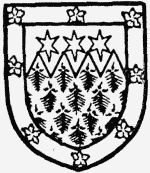
Estcourt. Ermine a chief indented gules with three six pointed molets therein within a border or charged with eight cinquefoils sable.
The manor-house of Wiggenhall, which is quite apart from the estate of that name, seems to have been occupied by the Deacon family towards the end of the seventeenth century. In 1678 a rent from the manor was paid by Thomas Deacon, (fn. 192) and Thomas Deacon of Wiggenhall died in 1780 and was buried in Watford church. (fn. 193) There are other inscriptions to members of the family as late as 1864. (fn. 194) The east window in the church of St. Andrew is the gift of Jonathan King who lived at Wiggenhall in 1873, (fn. 195) and probably succeeded the Deacons. It is now the property of Mr. Joseph Gutteridge Smith.
The manor of MUNDEN or MERIDEN was given by Abbot Richard (1097–1119) to Geoffrey de Mappeham in exchange for the land of Bradway, (fn. 196) and was confirmed to the monastery by Henry II and King John, (fn. 197) as lands of the knights of St. Albans. Raicus de Meriden was holding land of the abbot of St. Albans in 1166, (fn. 198) and Roger de Meriden his son held land of the abbot in 1210–12. (fn. 199) He was probably succeeded by his brother Thomas, and Roger son of Thomas was holding a sixth and a thirtieth part of a knight's fee in Meriden towards the end of the thirteenth century. His son Roger held courts at Meriden in 1298–9, (fn. 200) and must have died between 1303 and 1308, for he was holding the manor at the earlier date, and had been succeeded by his son John before 1308. (fn. 201) In 1351–2 the manor was granted by John de Meriden to John de Raynford, clerk, who already held it for life. (fn. 202)
This grant seems to have been made for the purpose of conveying the manor to the abbey of St. Albans, for Abbot Thomas (1349–96) bought it of John de Meriden for £80 and an annuity of 10 marks and a robe yearly during his life. (fn. 203) The abbot assigned this manor to the bursar of the monastery. (fn. 204) Half an acre of land in the meadow called 'Myrydenmede' was granted in 1367 by Thomas abbot of St. Albans to the prioress of Markyate. (fn. 205) In 1440 the abbot was presented for not mending the bridge of Meriden, but proved himself to be exempt from the liability. (fn. 206)
The manor was held under a lease from the abbot at the time of the Dissolution by Robert Betryce, (fn. 207) and it was granted with the woods called Bondegrove and Bondbushes, and tithes in Largerstrete and Walshall meade, in 1546 to Edward Waldegrave. (fn. 208) He sold it in the same year to Sir Anthony Denny, (fn. 209) who died seised of it in 1549 leaving Henry his son and heir. (fn. 210) Henry died in 1574, when the manor passed to his son Robert, (fn. 211) who dying a minor two years later was succeeded by his brother Edward, then aged seven years. (fn. 212)
Edward, Lord Denny, sold this manor with the exception of the site in 1607 to Robert Briscoe of Aldenham, (fn. 213) who conveyed it in the same year to Sir Baptist Hicks and William Toperley, of London. (fn. 214) They sold the manor in the following year to Sir Charles Morrison, son-in-law of Sir Baptist, (fn. 215) who thereupon settled it upon himself and Lady Mary his wife. (fn. 216) Upon the death of Charles in 1628 the manor, which already seems to have become merged in that of Parkbury, (fn. 217) came to his daughter Elizabeth the wife of Arthur Capell, (fn. 218) and its subsequent descent is the same as that of Cassiobury (q.v.).
The site and farm of the manor were sold by Sir Edward Denny in 1607–8 to Thomas Ewer of the Lea, (fn. 219) with remainders for life to John Warner and Anne, wife of Thomas Ewer, and after their death to David Ewer, son of Thomas. (fn. 220) John Warner predeceased Thomas, on whose death in 1628 the site came to his son David, (fn. 221) who dying in 1630 was succeeded by Henry his brother and heir. (fn. 222) It descended in the family of Ewer till 1715, when Henry Ewer of Bushey Hall, son of Thomas Ewer, sold it to John Rogers of New Brentford and Lewis his brother in trust for John and his heirs. (fn. 223) John Rogers died in 1750 and bequeathed Meriden to his brother Humphrey with remainder to Elizabeth daughter of another brother Francis. (fn. 224) Elizabeth, to whom the estate eventually passed, married Armstead Parker of Peterborough, and on her death in 1787 it came to her son Rogers Parker, who died unmarried in 1828–9. He left the estate to Elizabeth Margaret wife of George Hibbert, (fn. 225) daughter of his sister Mary Fonnereau, on whose death in 1841 it came to Nathaniel Hibbert her eldest son. (fn. 226) He died in 1865 without surviving male issue, leaving Meriden to his wife Emily, on whose death in 1874 it passed under her will to her grandson the Hon. Arthur Henry Holland, son of her daughter, Elizabeth Margaret and Henry Thurstan Holland, first Viscount Knutsford, who on coming of age took the additional surname Hibbert, (fn. 227) and is the present owner of the estate.
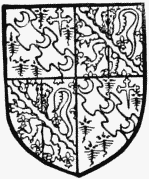
Holland-Hibbert. Ermine a bend nebuly sable with three crescents argent thereon and a crosslet fitchy sable in the cantle, for Hibbert, quartered with Party argent and azure powdered with fleurs-de-lis and a leopard rampant all countercoloured with a bend engrailed gules over all, for Holland.
The property has for some years been called Munden and comprises about 1,100 acres. (fn. 228) The house is in the parish of Watford, but a large part of the estate lies in the parish of St. Stephen's, and a small part of it in Aldenham. At the time of the death of Rogers Parker in 1828 Munden was merely an old fashioned farm-house and was converted into its present form by George Hibbert, (fn. 229) and by the present owner. There is a gravel-pit about 250 yards south of the house which marks a Roman interment. (fn. 230)
The manor of GARSTON extended into the parishes of St. Albans, Watford, Abbots Langley, and Leavesden. (fn. 231) By an undated charter, probably of the thirteenth century, Nicholas son of John de Garston gave to John de Westwick and Ellen his wife a messuage and land at Garston; (fn. 232) the manor was apparently held of the kitchener of St. Albans, who held a fourteenth part of a fee in Garston during the fourteenth century. (fn. 233) In 1355 Margaret wife of John de Westwick granted to Thomas Purchacour for life a capital messuage and land in Watford and elsewhere, which she held of Bartholomew Blaket. (fn. 234) Bartholomew, in 1368, conveyed the manor of Garston to John Curteys of Wymington. (fn. 235) In 1412 John Burgeys of Maldon and Joan his wife held it for the life of Joan, (fn. 236) and they in 1427 granted it to Robert Darcy. (fn. 237) By the middle of the fifteenth century it had come into the possession of William Halle of Shillington, co. Beds, 'a good and benevolent man,' of whom Abbot John of Wheathampstead purchased this manor in 1453. (fn. 238)
At the time of the Dissolution the manor was held by Richard Carter under a lease made in 1534 for thirty years, (fn. 239) and was granted by Henry VIII in 1544 to the said Richard and Thomas Palmer together with woods called Mote Grove and More Grove. (fn. 240) Richard and Thomas in the same year obtained licence to alienate half the manor to John Randoll and Agnes his wife. (fn. 241) Richard Carter died seised of half the manor in 1558 leaving William his son and heir, (fn. 242) on whose death in 1567 it passed to his son Robert, then a minor. (fn. 243) The other half passed from John Randoll and Agnes to co-heirs, William Pierson and Agnes his wife, Richard Haysse and Cecily his wife, and Michael Sare and Margaret his wife, the ladies probably being daughters of John Randoll. These co-heirs in 1582 conveyed their moiety to Henry Sare and Richard Wood, (fn. 244) who were probably trustees for Michael Sare and Margaret, for they in 1586 granted half the manor to Robert Carter and Petronilla his wife, who already held the other moiety. (fn. 245) In default of issue of Robert and Petronilla the manor was to pass to Walter, Francis, and Richard Curll, sons of William Curll in tail male, with remainder to the heirs of Robert Carter. (fn. 246) Robert died seised of the manor in 1632, holding one half in demesne and the other in tail male, leaving William his son and heir. (fn. 247) William sold the manor in 1666 to John Edlin and William Kentish, (fn. 248) who were probably trustees for John Marsh, who was lord of the manor in 1672, and whose house at Garston was licensed in that year as a place of worship for Nonconformists. (fn. 249) He died in 1681 and was buried in Watford church. (fn. 250) The manor passed to his son Joseph, whose daughter and heir Anne married Thomas Beech. (fn. 251) Thomas and Anne conveyed the manor in 1728 to Samuel Raymond, (fn. 252) who may have been a trustee for Richard Capper of Bushey, to whom the manor passed at about that time. (fn. 253) On his death Garston came to his son Francis, whose eldest son Richard succeeded to the estate on the death of his father, and on whose death in 1800 it passed to his son Robert. (fn. 254) In 1814 Robert Capper conveyed it to Stephen Moore, (fn. 255) but this conveyance was probably made for the purposes of a settlement, as Robert sold it two years later to John Falcon, (fn. 256) who held it till his death in 1854, when it was sold under the terms of his will to Henry Cobb, (fn. 257) on whose death in 1873 it came to his widow, Mrs. Mary Anne Cobb, who was residing there in 1899. Garston House is now the residence of Mr. Thomas Farries.
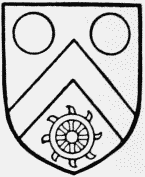
Carter of Garston. Argent a cheveron sable between two roundels vert in the chief and a Catherine wheel vert in the foot.
The origin of the manor of LEGATTS (Legattys, Legetts) is perhaps found in 83 acres of land held of the manor of Bushey by John Legat in 1451–2. (fn. 258) The first mention of it as a manor occurs in a suit of the reign of Henry VII or VIII. It then belonged to Dame Jane Kidwelly, widow of Sir Morgan Kidwelly, (fn. 259) and was leased by her to Agnes Shawarden. The suit arose on account of a distraint for rent due for the manor. (fn. 260) In 1551–2 John Snow and Katherine his wife conveyed a fourth part of a messuage called Legattys, in Watford, to Simon Hoddesdon, (fn. 261) who, with his wife Joan, sold it in 1553 to Thomas Spurling. (fn. 262) The manor, or reputed manor, afterwards passed to Sarah widow of Robert Hucks, the owner of Penne's Place in Aldenham and of the manor of Hartsbourne in Bushey, who in 1769 settled it upon herself for life, with remainder to her son Robert. (fn. 263) The manorial rights, if any ever existed, have long been lost, and the estate, now known as Legatt's Farm in Leavesden Green, passed in the same way as Penne's Place to Lord Aldenham.
REDHEATH is an estate about four miles north-west of Watford, on the borders of the parish of Rickmansworth, consisting partly of freehold and partly of copyhold land held of the manors of Croxley Hall and Cassio. It was occupied by the Baldwins in the early part of the sixteenth century, and remained with owners of that name till 1709, (fn. 264) when Thomas son of Henry Baldwin died without issue, and was succeeded by his nephew Charles, son of Charles Finch and Mary sister of Thomas Baldwin. (fn. 265) Charles Finch died without issue in 1718, and was succeeded by his brother John, from whom the estate descended in a direct line to Henry Baldwin Finch, the present owner. (fn. 266) The Baldwin family appear to have built a house here, but all of that building has disappeared. In 1712 Charles Finch added a new front to the house, and that date appears on it. Further additions were made in 1866 by Henry Charles Finch. The front part is the only old portion remaining. The house is a three-storied building of brick, the roof being surmounted by a large square wooden clock turret, with an open octagonal cupola on the top. The clock in the tower bears the inscription GEORGE CLARKE, WHITE-CHAPPLE, 1743. There are moulded brick cornices over the first-floor windows, and the entrance door, which is in the centre of the front, has a fine semicircular projecting wooden hood, supported on richly-carved brackets. There is a very fine avenue of beech trees, stretching from the back of the house to Chandler's Cross.
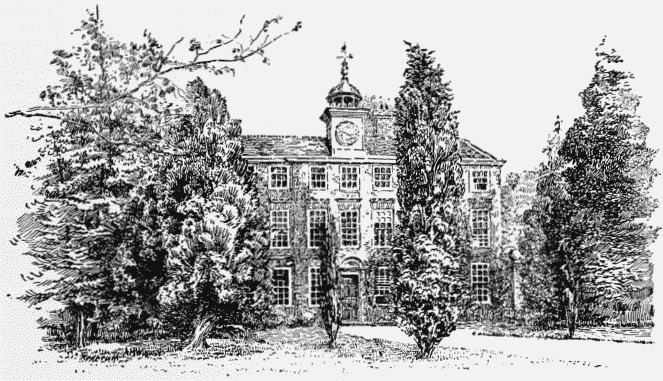
Redheath, Watford
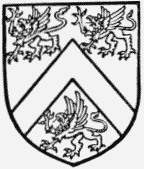
Finch of Redheath. Argent a cheveron between three griffons passant sable.
The tenement called HARWARD or HERWARD was acquired by Abbot Thomas Ramridge about 1506–7 from John Danyell, the land having previously been held by John Day. (fn. 267) It remained in the possession of the monastery till the Dissolution, (fn. 268) at which time it was in lease to Roger Wedon for eight years. (fn. 269) In 1556 it was held by Richard Wilson under a lease for thirty-one years, of which ten had then expired. (fn. 270) It was granted by Queen Elizabeth in 1577–8 to William Edlyn for three lives, (fn. 271) and at his death, in 1595, it came to his son William. (fn. 272) The tenement was still in the hands of the king in 1608, and was leased to a tenant whose name is not given. (fn. 273) In the following year it was granted with Watford manor to Thomas Marbury and Richard Cartwright, (fn. 274) and its subsequent descent has been identical with that of Watford manor (fn. 275) (q.v.).
The LEA or LE LEY was at the time of the Dissolution part of the possession of the monastery of St. Albans. (fn. 276) In 1541 the tenement was held by William Ewer in right of his wife Elizabeth daughter of Thomas Hill, who had apparently inherited it after the death of Edward Hill, probably a brother. The tenement had formerly belonged to Thomas Chamberleyn and Cecilia his wife, afterwards to William Robyn, and then to William Smith. (fn. 277) A certain Richard Hill was holding land in Watford in 1513. (fn. 278) The estate descended from father to son in the family of Ewer (fn. 279) till 1715, when it had probably become merged in the Meriden estate (q.v.), and was sold by Henry son of Thomas Ewer to John Rogers. (fn. 280)
The Lea was in 1899 the residence of Mr. Ernest Houghton Browne, from whom it passed shortly afterwards to Mr. S. Thornely Mott. It is now a farm-house in Leavesden.
The manor of GROVE was held as of the manor of Cassiobury. (fn. 281) In 1294–5 John de Brittewell and Sarah his wife conveyed land and a third part of a mill in La Grava to Albreda de Brittewell and her two sisters Alice and Ellen. (fn. 282) Thomas de Harpesfield and Joan his wife were in 1324–5 holding land in the demesne of St. Albans at La Grava in the vill of Cassio, and the abbot released them from a rent due for it. (fn. 283) There is a monumental inscription in Watford church to John Heydon of the Grove, who died in 1400. (fn. 284) John Rayner and Joan his wife conveyed the manor in 1481–2 to John Fortescue, John Sturgeon, John Forster, and Henry Heydon, to the use of John Fortescue. (fn. 285) Owing to proceedings in Chancery the estate passed to John Melksham or Melsam, who died seised of it in 1487, leaving John his son and heir, (fn. 286) who in 1503, with his wife Elizabeth, granted it to Reginald Pegge subject to a rent of £10. (fn. 287) From Reginald the manor passed to his son William, who, with Margaret his wife, and Geoffrey Oxley and his wife, late wife of Reginald Pegge, conveyed the manor in 1518 to William and John Heydon, (fn. 288) who were probably descendants of the John Heydon who held the manor at the end of the fourteenth century. William Heydon died seised of it in 1545, leaving Henry his son and heir, (fn. 289) who died in 1559, (fn. 290) and was succeeded by his son Francis, who sold the manor in 1602 to Clement Scudamore. (fn. 291) Clement sold it in 1631, with two water-mills under one roof, called the Grove Mills, to Sir William Ashton, (fn. 292) from whom it passed to his second son Robert. On the death of Robert's son William without issue in 1703 the manor passed to Sir William Buck, grandson of William son of Sir William, the purchaser of the estate. (fn. 293) He died in 1717, and the Grove came to his son Charles, (fn. 294) who in 1728 sold it to the trustees of Fulk Greville, then a minor. (fn. 295) He in 1743 sold it to Arthur Mohun St. Leger, third Lord Doneraile, (fn. 296) who conveyed it in 1748 to Charles Unwin, probably for the purposes of a settlement, (fn. 297) for on the death of Lord Doneraile in 1750, without issue, it passed under his will to his cousin Elizabeth St. Leger, afterwards the wife of Major Ralph Burton. (fn. 298) On her marriage the estate was vested in trustees, who sold it in 1753 to the Hon. Thomas Villiers, second son of William, earl of Jersey. (fn. 299) In recognition of his diplomatic services he was created Baron Hyde of Hindon, co. Wilts., in 1756, and earl of Clarendon in 1776, and from him the manor of Grove has descended with the title to Sir Edward Hyde Villiers, the present earl. (fn. 300)
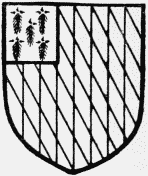
Buck. Lozengy bendwise or and azure with a quarter ermine.
George William Frederick, fourth earl of Clarendon, was a statesman of great ability. When little more than a boy he entered the diplomatic service, and became attaché to the British Embassy at St. Petersburg. He was sent in 1833 as Envoy Extraordinary to Madrid, a post rendered at that time very difficult on account of the civil war. The conclusion, in 1834, of the treaty between England, Spain, France, and Portugal, called the Quadruple Alliance, was largely the result of his efforts. He succeeded to the earldom in 1838, and entered the ministry in the following year as Lord Privy Seal, but he soon came into collision with Palmerston on his Syrian policy. He was made Lord Lieutenant of Ireland in 1847, and during his term of office had to cope with famine, the Young Ireland agitation, the Smith O'Brien rising, and the Orange disturbances. His life was constantly in danger, but he carried Ireland through a period of conspiracy and rebellion with little or no bloodshed. He died in 1870, and was buried at Watford. (fn. 301) The Grove is a fine red-brick house of eighteenth-century date, of three stories, the top story being of later date than the rest, and contains a valuable collection of paintings, chiefly portraits.
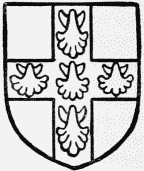
Villiers, Earl of Clarendon. Argent a cross gules with five scallops or thereon.
CARPENDERS PARK. This estate took its name from the family of Carpenter, who were in possession of it during the seventeenth and eighteenth centuries, and to whom there are various inscriptions in the church. (fn. 302) It was formerly included in the manors of More and Wiggenhall, and, after the Carpenders ceased to possess it, seems to have been divided into a number of small holdings. During the reign of George II the house and about 150 acres of land adjoining were in the possession of Hatch Moody of St. Margarets, county Middlesex. By his will dated 1747 he left the estate to his son Samuel, with an entail on his heirs male and contingent remainder to his daughters Ann and Letitia. (fn. 303) Samuel rebuilt the house at Carpenders, and died in 1823, having survived his two sisters and his only child Anna Maria. By his will he left the estate to his nephew the Rev. Matthew Skinner, of Wood Norton, county Norfolk, in tail male with remainder to his sister Mary Anne Longmore of Chelmsford, and to her son William Longmore. (fn. 304) William Longmore died before the testator, and Matthew died in 1825, when Mary Anne Longmore came into possession. She, with her sons and grandsons, conveyed it in 1846 to Jonah Smith Wells of Islington, and he in 1862 sold it to Robert Russell Carew, (fn. 305) from whom it has come to Mrs. Carew, the present owner.
The manor of NEWHALL, in Watford and Sarratt, belonged to the abbey of St. Albans, and was leased in 1528 to Thomas Johnson for forty-one years. (fn. 306) The site of the manor was granted in 1543 to Richard Andrews and Nicholas Temple, (fn. 307) who conveyed it in the same year to Thomas Palmer. (fn. 308) Thomas sold it in 1546 to Thomas Johnson, (fn. 309) who died seised of it in 1577, leaving Francis his son and heir, (fn. 310) to whom livery was made in the following year. (fn. 311) He and his son Francis sold the manor in 1608 to Richard Day of Westwood, in Abbots Langley, (fn. 312) who in 1613 gave it to his son Benjamin. (fn. 313) The estate was probably sold by Ralph Day about 1750, and was bequeathed by Judith Nicholls of Hertford, widow, in 1767, to her son-in-law Lewis Weston, with remainder to Judith, his wife, her daughter. Judith Weston by her will proved in 1815 gave it to her daughter Sarah, wife of William Dillwyn, who died intestate in 1815, and was succeeded by her brother Lewis Weston. He sold the manor in 1826 to Ralph Day, son of Ralph Day, mentioned above. (fn. 314) Newhall has now lost its manorial rights, and is incorporated in the Micklefield Green estate (q.v.). (fn. 315) Its site probably exists at New Hall Farm, in this parish.
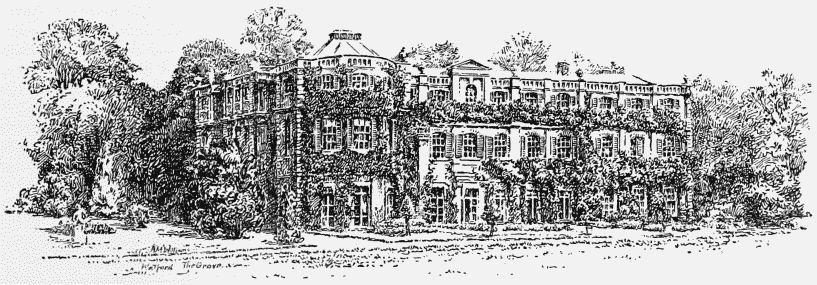
The Grove, Watford
The manor of EASTBURY, which lies to the east of the parish, was part of the possession of the abbey of St. Albans in the thirteenth century. It had been assigned by Abbot Roger for the maintenance of an anniversary, but on his death was seized by the escheator, and was not recovered by the convent without some trouble. (fn. 316) The manor-house was rebuilt at the end of the fourteenth century. (fn. 317) It seems to have been alienated, perhaps by Abbot Thomas to William Flete, for he, on his death bed in 1428, bequeathed it to the convent of St. Albans. (fn. 318) In 1456 it was granted by the abbot to Sir Ralph Boteler, lord of Sudeley, in exchange for tenements in London, (fn. 319) and shortly after that time its manorial rights probably became merged in those of the manor of More, in Rickmansworth, with which it descended. Eastbury is now an estate lying partly in this parish and partly in that of Rickmansworth. When the ecclesiastical parish of Oxhey was formed in 1879 Eastbury was excepted from it, as it had already been made over to the vicarage of Northwood in Middlesex. It was at that time occupied by David Carnegie. (fn. 320) Sir John Vaughan, an eminent judge, died at Eastbury Lodge in 1839. (fn. 321)
CALLOWLAND or GAMELL is an estate to the north of the town of Watford. In 1380–1 licence was given to John Turk, Robert Rygge, and others to alienate nine shops, land, meadow, and rent in Watford, Little Bushey, Langley, and St. Albans to the master and scholars of Merton Hall, Oxford, in part satisfaction of £40 of land, tenements, and rent which they had licence to acquire. (fn. 322) Charles I in 1633–4 confirmed all grants made to the college, and among their possessions is mentioned the manor called Callowland or Gamell, in the parish of Watford, and land in the meadows called Merton Hall Croft and Chamberburg Croft. (fn. 323)
It consisted in 1881 of a farm and about 120 acres of land near the railway station, belonging to the Warden and Fellows of Merton College, and negotiations were then in progress for its sale to the earl of Essex. (fn. 324) It has now been sold in building plots, and is becoming covered with small houses and shops.
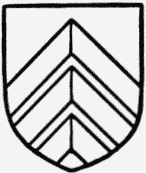
Merton College, Oxford. Or three cheverons party and countercoloured azure and gules.
There is some indication that there was a manor of the RECTORY of Watford before the Dissolution, as among the revenues of the abbey of St. Albans are numbered perquisites of court of the rectory of Watford, (fn. 325) but no further reference to it has been found.
